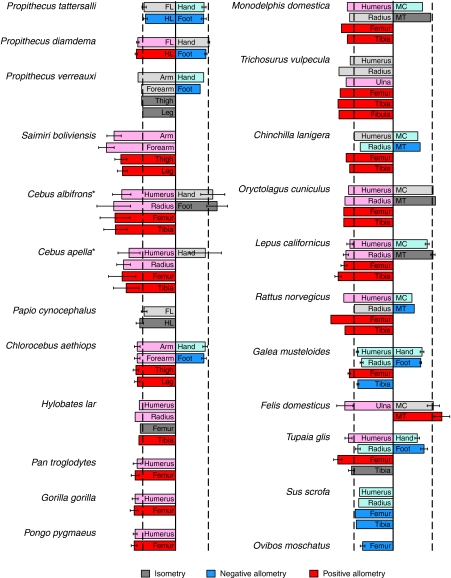Fig. 8.
Scaling of limb growth in primates and other mammalian taxa. In each set of bar graphs, the left hand panels represent complete limbs or stylopodia/zeugopodia (i.e. arms, forearms, thighs or legs) and right-hand panels represent autopodia (metacarpals/metatarsals or complete hands and feet). Forelimb segments are distinguished by lighter shading. Except where indicated by the asterisks next to the species name, allometric exponents were calculated from reduced major axis regressions of segment length on body mass. 95% confidence intervals on the exponents are shown where available. Dashed lines indicate isometry (i.e. slope equal to 0.333). Data sources: Propithecus tattersalli [golden-crowned sifaka (Ravosa et al., 1993)] Propithecus diadema [diademed sifaka (Ravosa et al., 1993)]; Propithecus verreauxi [Verreaux's sifaka (Lawler, 2006)]; Saimiri boliviensis [Bolivian squirrel monkey (this study)]; Cebus albifrons [white-fronted capuchin monkey (Jungers and Fleagle, 1980)]; Cebus apella [tufted capuchin monkey (Jungers and Fleagle, 1980)]; Papio cynocephalus [yellow baboon (Raichlen, 2005)]; Chlorocebus aethiops [vervet monkey (Turner et al., 1997)]; Hylobates lar [white-handed gibbon (Jungers and Cole, 1992)]; Pan troglodytes [common chimpanzee (Hartwig-Scherer and Martin, 1992)]; Gorilla gorilla [gorilla (Hartwig-Scherer and Martin, 1992)]; Pongo pygmaeus [orangutan (Hartwig-Scherer and Martin, 1992)]; Monodelphis domestica [gray short-tailed opossum (Lammers and German, 2002)]; Trichosurus vulpecula [brushtail possum (Lentle et al., 2006)]; Chinchilla lanigera [chinchilla (Lammers and German, 2002)]; Orytolagus cuniculus [domestic white rabbit (Lammers and German, 2002)]; Lepus californicus [black-tailed jackrabbit (Carrier, 1983)]; Rattus norvegicus [rat (Lammers and German, 2002)]; Galea musteloides [cui (Schilling and Petrovitch, 2006)]; Felis domesticus [domestic cat (Carrier, 1983)]; Tupaia glis [tree shrew (Schilling and Petrovitch, 2006)]; Sus scrofa [domestic pig (Liu et al., 1999)]; Ovibos moschatus [musk ox (Heinrich et al., 1999)].

